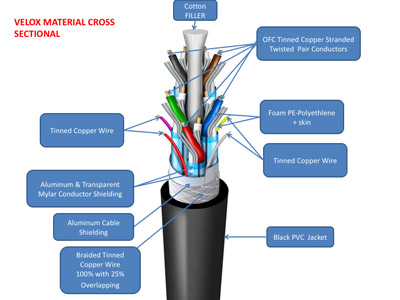
Part 6 of 6 - Construction of a HDMI Cable: Testing Procedures
Tuesday, October 27, 2015 7:59:41 PM America/New_York
If you have made it this far in the series you have seen how important each part of the cable is at least in our option. The real question is, how can this be validated as truth and not just be set aside as the ramblings of a PR/Marketing department?
Let us return for a moment to a contributing factor in what triggered this series, Still More Reasons Why All HDMI® Cable Are The Same and "4K HDMI Cables Are Nonsense". The issue here for us is the testing methodology, all that was done to verify the quality of a given cable was (A) borrow a tone generator/scope and sweep/Eye pattern test one channel at a time of the three video channels and (B) plug the cables in between a source and a display. This is not a good or accurate way to test as timing of the 3 channels together is critical and without this concurrent channel testing results will be skewed.
So, how can you know if a cable is worth a damn? DPL testing that’s how.
Part 5 of 6 - Construction of a HDMI Cable: Termination
Tuesday, October 20, 2015 8:17:23 PM America/New_York
In the previous installments of this series, we have discussed everything needed for the best performing HDMI® cable and to improve overall performance in a system. With that being said without the proper termination quality parts will mean nothing and the cable will not provide top performance.
It is very important to control the heat, silver content, quantity and flow of the solder. Less is more in this application and of course “Cleanliness is next to Godliness”. Extra solder closes the gaps between the connection points and that can/will create its own RF field. To add insult to injury, when it comes to the soldering process ROHS (Federal Lead standards) has mandated that lead be mostly removed from solder for safety reason. Unfortunately this means that solder most be applied at a higher temperature for it to flow. Higher temps mean a greater chance of thermal damage to any board level components.
Part 4 of 6 - Construction of a HDMI Cable: Silver Content
Tuesday, October 13, 2015 8:22:00 PM America/New_York
Now we are starting to get into the more esoteric physics of an HDMI® cable. For many years, mainstream analog audio cable manufacturers talked about “Skin Effect” and how higher frequency’s tend to migrate to the surface of a cable and that lower frequencies stayed in the middle. As it turns out, there is some truth to this statement. Oh, not in the analog audio domain, that is still BS (in our opinion). However, in the high speed world of HDMI surface silver content and the type of dielectric do play a part in the performance of a HDMI cable. Now just throwing a thicker cost of silver onto the copper is not the complete answer. There must be a proper balance. Copper provides a stable high tinsel substrate for the silver plating, this will help the wire to keep its original length and shape which is necessary for the higher bandwidth and speeds (see #1 & #3).
Part 3 of 6 - Construction of a HDMI Cable: Bandwidth and Speed
Tuesday, October 6, 2015 5:05:00 PM America/New_York

Bandwidth and Speed are very important when discussing the construction of a HDMI® cable. One has to have a general understanding of how these two words pertain to cables as well as how they play into the cables functional capability. Bandwidth and Speed are a very difficult and confusing concept for most people to grasp.
What is Bandwidth? What is speed?
Although bandwidth and speed have much in common, they are different and are frequently and incorrectly used by both consumers and the manufacturers to express the same thought.
- Bandwidth refers to how much data can pass thru a device at the same point and time.
- Speed refers to how quickly a device can create the data.
Part 2 of 6 - Construction of a HDMI Cable: Shielding
Thursday, October 1, 2015 6:35:00 PM America/New_York

The second part of this blog series we are discussing the two types of shielding and why they are important. The two types of shielding that a HDIMI cable should have to provide the best protection are braid and foil.
A braid shield keeps outside noise from interfering with your HDMI® cable by cutting down the 110/60Hz interference. If outside RF/EMI noise penetrates the HDMI cable it can cause all sorts of havoc. Since pretty much everyone has had some experience with HDMI Cat/x Extender failure due to high voltage switched devices (lights, motors, etc.) cause a short term dropout of the HDMI signal, there is an understanding of this issue.
Foil shield reduces the high frequency interference and keeps the noise within the cable. A foil shield also protects components from damage caused by spurious HDMI noise from running amok in your system like a gremlin. Foil shielding around the TMDS feeds of a HDMI cable also keeps the noise from causing problems with infra-red components and RF control systems.











